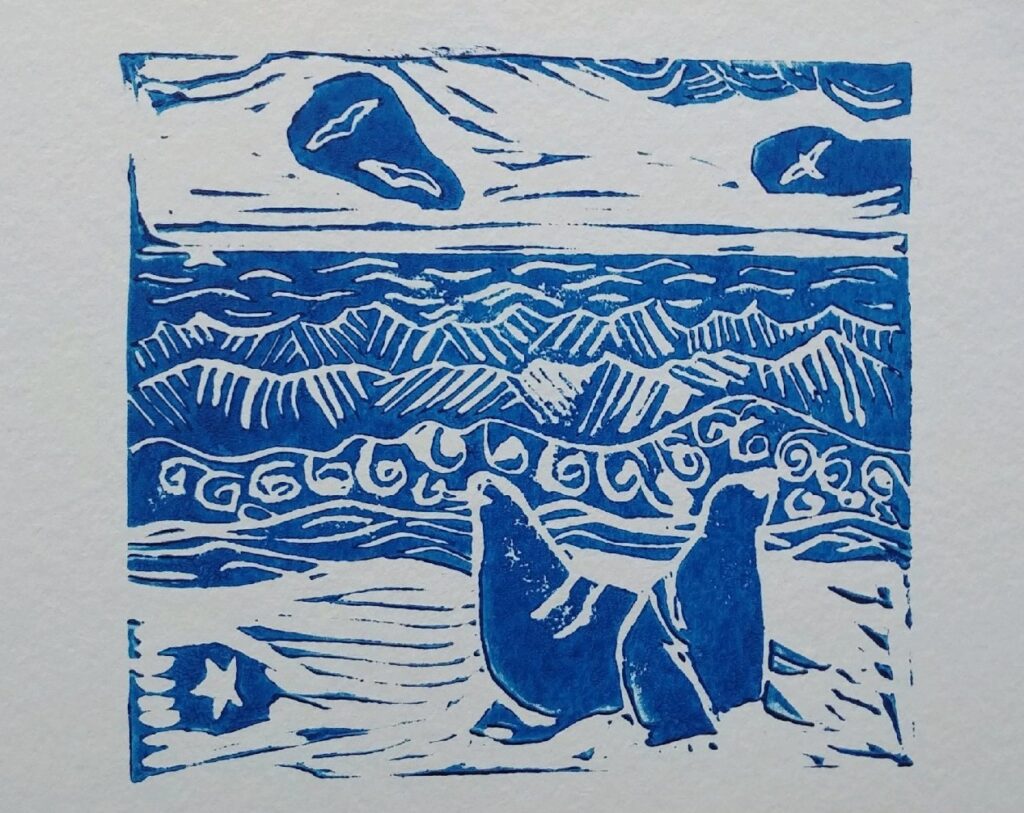
Sea lions are a carnivorous aquatic mammal, called a pinniped, characterized by external ear flaps; long fore-flippers; the ability to walk on all fours; short, thick hair; and a big chest and belly. California sea lions have broad front flippers and long, narrow snouts. Adult males have pronounced forehead crests crowned with tufts of blonde or lighter hair, and three to five claws on their hind flippers. They are related to walruses and seals.
These “eared seals” are native to the West Coast of North America. Their range extends from the subarctic to tropical waters. They are not found in the Atlantic Ocean. They prefer sandy beaches or rocky coves for breeding and haul-out sites. Along the West Coast, they also haul out on marina docks as well as jetties and buoys. California sea lions range from southeast Alaska to the Pacific coast of central Mexico. Their primary breeding range is from the Channel Islands in southern California to central Mexico.
California sea lions are playful, intelligent, and very vocal (sounding like barking dogs). Each pup and female has a unique scent, and a female can locate her pup among hundreds of others by her pup’s unique vocalization and then smell is used as the final check.
Feeding mainly offshore in coastal areas, sea lions eat a variety of prey—such as squid, anchovies, mackerel, rockfish, and sardines—found in upwelling areas. They also may take fish from commercial fishing gear, sport fishing lines, and fish passage facilities at dams and rivers.
They have the ability to dive to great depths and for long periods of time as they can control heart rate, gas exchange, digestion rate, and blood flow avoiding side effects of high pressure. Compared to terrestrial mammals, sea lions have a higher tolerance for storing CO2 which is what normally tells mammals that they need to breathe.
They have an average lifespan of 20–30 years. A male California sea lion weighs on average about 660 pounds and is about 8 feet long, while the female sea lion is smaller weighing 220 lb and is 6 ft long. Sea lions consume large quantities of food and are known to eat about 5–8% of their body weight 15–35 lb at a single feeding. Sea lions can move around 16 knots (18 mph) in water and at their fastest reach a speed of about 30 knots (35 mph). Three species are listed as endangered.
Climate change has resulted in increased toxic algae blooms in the oceans. These toxins are ingested by sardines and other fish which are then eaten by the sea lions, causing neurological damage and diseases such as epilepsy.
Eared sea lions, raise their young, mate, and rest on land. Sea lion mating is often polygamous with males usually mating with different females to increase fitness and success. Polygamous males rarely provide parental care towards the pup. Males occupy and defend a territory with resources or features attractive to females during sexually receptive periods.
Human presence and recreational activities can cause sea lions to engage in violent and aggressive behavior. When humans come close, such disturbances can cause sea lions to retreat and abandon haul out time.
Sea lions often rest aboard fishing boats, sometimes causing the boats to sink. Fishermen try to prevent them from coming aboard by putting up barbwire as a barrier, but this can cause severe injuries. WWF helped support a project on San Cristóbal Island that built and installed two floating bases for sea lions to rest on and a “primary care nursery” for sea lions and other species.
Like all marine mammals, they are protected under the Marine Mammal Protection Act and their populations has been increasing.
One common behavior—called “rafting”—can make a sea lion look like it’s caught in a net. A rafting sea lion holds its flippers above the water for a long time, motionless, to rest and regulate its body temperature.
Protection and conservation measures focus on:
- Reducing interactions with commercial fishing gear
- Minimizing harassment and illegal feeding
- Responding to dead, injured, or entangled sea lions
- Encouraging responsible viewing of wild sea lions
- Minimizing the effects of vessel disturbance and other types of human impacts
This print is a part of a series on Conservation of California Critters.